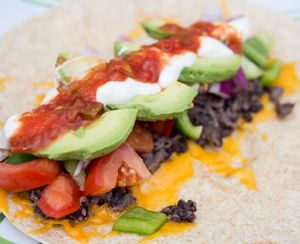You may have heard about our report yesterday on endometrial cancer: physical activity and coffee help protect against the cancer, but excess body fat and a high-glycemic-load (GL) diet increase risk.
I talk about what glycemic load means here – basically, it’s a measure of how much a food increases your blood sugar. But how would you know if your diet is high or low GL?
There are a lot of glycemic load charts out there that compare foods. However, using glycemic load to select your foods doesn’t mean you will necessarily have a healthful or cancer preventive diet. (Meats and fats don’t contain carbohydrates, so they are not even listed on the GL charts.)
So what should your plate look like to make it fit the low-glycemic-load and cancer protective recommendations? It looks a lot like our New American Plate. Here are four easy steps to making your plate fit a low-glycemic-load diet – all just by looking at your plate.
1. Put Plant Foods on Your Plate
Watery vegetables, whole fresh fruits, beans and legumes, whole grains and nuts are low to moderate GL and they’re packed with cancer-fighting vitamins, minerals, and phytochemicals.
Try this: Make a burrito with whole-wheat tortillas, pinto beans, red peppers, tomatoes and lettuce. Serve with a mango salsa.
2. Focus on Whole Foods
Whole plant foods contain natural fiber and water that help you get, and stay, full – helpful for a healthy weight. You can also use frozen or canned vegetables, fruit and beans because that minimal processing leaves most nutrients and fiber intact.
Try this: Add canned chickpeas to your tossed salad for extra protein.
Whole grains are lower glycemic load than are refined/processed grains. Refined grains have the bran (fiber) and germ (healthy fats, vitamins, minerals) removed, so you lose those protective factors and have a food that is digested quickly.
Try this: Choose a small, whole wheat bagel with peanut butter instead of a large white flour bagel and jelly.
3. Add Healthy Proteins and Fats
Eating protein and fat along with higher GL foods can help blunt the blood sugar spike, contributing to a lower GL diet. Think 1/3 or less of your plate with protein – great choices include fish, poultry and beans. Moderate amounts of low-fat dairy and lean red meat (no more than 18 oz. cooked per week) also contribute protein.
Including a little fat from foods like nuts and avocados, stir-frying veggies and grains in small amounts of oil, or using salad dressing on a large green salad slows down absorption of your meal and helps you stay full longer.
Try this: Serve a 3-4 ounce salmon fillet alongside a small sweet potato topped with spiced walnuts; and add a tomato, cucumber and onion salad.
4. Pay Attention to Portion Size
Eating multiple portions of a low GL food like bread or cereal at one time doesn’t mean you have a healthy meal – you may well eat more calories than you need, eventually leading to weight gain.
Try this: Portion out 1/2 – 1 cup brown rice pilaf with a few nuts, 1-2 cups greens sautéed in olive oil and 3 oz of baked chicken; top off the meal with 1/2 cup plain yogurt mixed with ½ cup fresh blueberries.
Learn more about the New American Plate
Sign up for the New American Plate Challenge starting September 30.





